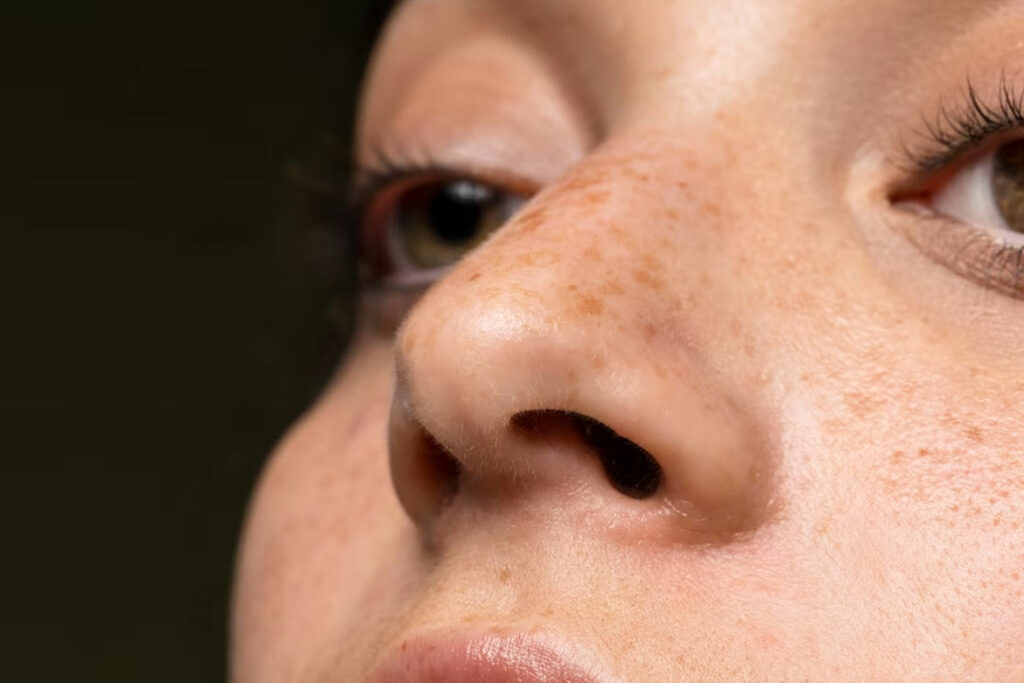Numerous people suffer from the skin condition melasma. Your skin appears darker in certain areas than others as a result. Although it typically occurs on the face, it can also occur on other exposed body areas. Melasma is also referred to as chloasma or the “mask of pregnancy” since it frequently affects pregnant people. Melasma is not harmful, but it might make you feel self-conscious about your appearance. The silver lining, however, is that there are approaches to treating it and halting its progression.
What brings on melasma?

Nobody is certain of the exact cause of melasma, although a number of factors, including:
Sun exposure: The pigment that gives your skin its colour, melanin, can be increased by exposure to the sun. Your skin is shielded from UV damage by melanin, but too much of it can lead to dark areas. This explains why melanomas typically worsen in the summer and improve in the winter.
Hormonal adjustments: Hormones like oestrogen and progesterone regulate a variety of bodily functions, including the appearance of your skin. Melasma can be brought on by changes in these hormones, notably during pregnancy, while using birth control pills or hormone replacement therapy, or during menopause. After pregnancy or when you stop using hormonal drugs, melasma frequently goes away.
Genetic factors: Some people may have genetic predispositions to melasma. You may be more likely to get melasma if your parents or other close family members do.
Some goods or treatments that irritate your skin might potentially cause or exacerbate melasma. These include cosmetics, lotions, cleaning products, scents, hair colours, waxing, laser treatment, and chemical peels.
How is melanomas identified?

A healthcare provider or dermatologist (a physician who focuses on skin conditions) may typically diagnose melasma by examining your skin and asking you some questions. Additionally, they may perform certain tests to rule out other causes of your skin pigmentation, such as skin cancer or fungi infections. There are a few tests they might run:
They examine your skin with a special light called a “Wood’s lamp” to see how deeply the melasma has affected the layers of your skin. Additionally, it can assist them in determining whether you have any bacterial or fungal infections that might resemble melasma.
A little piece of your skin is removed for a skin biopsy, which is then examined under a microscope. They can use it to rule out any other severe skin conditions and confirm that you have melasma.
Treatment of melasma:
Based on severity, location on body, and your preferences, melasma may be treated using a variety of approaches. The following are some typical treatments:
Topical medications: These are lotions or gels that you apply to your skin to lighten it. They might contain substances like hydroquinone, azelaic acid, kojic acid, or tretinoin that prevent the synthesis of melanin or eliminate surplus pigment. These drugs may not start working for a few weeks or months, and they may have unpleasant side effects like dryness, itching, or redness. A dermatologist or other healthcare provider should be consulted before using them so they can determine the proper dosage and monitor your results.
Oral drugs: There are some oral pills that help to lighten skin tone and reduce inflammation. Anti-inflammatory medications like corticosteroids or tranexamic acid that stop the production of melanin or lessen blood vessel swelling may be among them. These drugs could have unwanted side-effects like weight gain, gastrointestinal upset, or bleeding issues. They should only be used for severe cases of melasma and under the guidance of a doctor or dermatologist who can monitor your blood pressure and liver function.
Procedures: Clinical medical therapies entail physically or chemically removing or killing the damaged skin cells. The top layer of the skin may be removed with the use of chemical peels, dermabrasion, microdermabrasion, laser therapy, or intense pulsed light (IPL) therapy, revealing a lighter and smoother layer of skin beneath. These procedures may produce effects more quickly than topical or oral drugs, but they also carry a higher risk of scarring, infection, or worsening of melasma. Professionals with training should do them so they can select the optimal method and level of vigour for your skin type and condition.
How Melasma can be prevented?

Read more: Know the benefits of fish liver oil for your skin, how to use this?
By avoiding or minimising its triggers and risk factors, melasma can be prevented or controlled. You can accomplish a variety of activities, including:
Avoiding the sun Given that sun exposure is one of the main causes of melasma, this is the most crucial step in prevention. Every day, you should use sunscreen with a minimum SPF of 30 and reapply it every two hours when you are outside. Additionally, you should avoid being in the sun between the hours of 10 a.m. and 4 p.m. by donning protective gear such as hats, sunglasses, and long sleeves.
You should consult your dermatologist or healthcare provider about additional possibilities if you develop melasma as a result of hormonal changes, such as pregnancy or birth control pills. In addition, you should refrain from taking hormone replacement medication unless your doctor specifically recommends it.
Use soft skincare products that won’t irritate your skin, and stay away from abrasive procedures like waxing, laser therapy, and chemical peels that could exacerbate your melasma. To keep your skin hydrated and healthy, you should moisturise it frequently.
What is melasma’s prognosis?
Even after therapy, melasma is a chronic illness that may recur or persist over time. It does not, however, affect you physically and does not raise your risk of developing skin cancer. If you are unhappy with the way you look, melasma may affect how you feel about yourself and your life. However, there are techniques to deal with it, such as:
Getting expert assistance: You should consult a dermatologist or healthcare provider who can accurately identify your condition and provide you with efficient treatment alternatives that suit your requirements and preferences. Additionally, they can monitor your development and alter your treatment strategy as necessary.
Seeking emotional support: You should speak with a trusted person, such as a member of your family, close friends, or a counsellor, who can listen to your feelings and provide you with consolation and guidance. You can also participate in online discussion boards or support groups where you can exchange tales and gain knowledge from people who have related conditions.
Look for cosmetic remedies: To temporarily mask your melasma spots, apply cosmetics items like foundation or concealers that match your skin tone. You can also experiment with natural therapies that could brighten your skin, such aloe vera gel, lemon juice, or turmeric paste.
Conclusion:

Read more: Home remedies to make your skin thicker
Melasma is a common skin condition marked by dark patches of skin that develop as a result of excessive melanin production brought on by sun exposure, hormonal changes, or genetic predispositions. Although it is not hazardous, it could change the way you feel and appear. There are many melasma treatments available, including lotions, tablets, and surgeries that can lighten your skin and help your problem. To avoid or reduce its recurrence, you should also take precautions to prevent it, such as using sunscreen, managing your hormones, and taking care of your skin. Melasma may be difficult to live with, but with the right diagnosis, care, and support, you may effectively manage it.
